Hammelburg
Patton’s Task Force Baum Raid Lives Again!
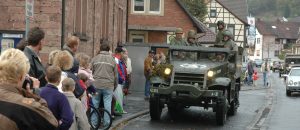
What in the world is all the ruckus? The unmistakeable whine of a dozen vintage Willys Jeeps convoying through one German village after another — then a half-track — all vehicles filled with scores of American GIs wearing the insignias of the legendary 4th Armored Division, the spearhead of Patton’s Third Army?
It looks like a movie set from “Band of Brothers” without the guns. Why are hundreds of German civilians lining the roads? Many scratch their heads in puzzlement, while others wave, cheer, and smile. Reporters and TV crews are following closely. Now the mayor appears carrying a white flag and surrenders the town. The commanding American officer in the lead Jeep who accepts the surrender is none other than 84-year-old Major Abe Baum.
A few of the older Germans remember the actual event from Mar. 26-28, 1945, being commemorated here today, and some of them crowd around Baum’s Jeep as if he were a rock star, some with tears in their eyes, to tell their stories, to shake the hand of their former enemy, and to seek his autograph. Then they go together, both Americans and Germans to the Town Hall for an official reception, speeches, and food, drink, and good fellowship. At one stop in Gemuenden, Mayor Schiebel jokes, “I trust we are giving you a better reception than the first time you came here.”
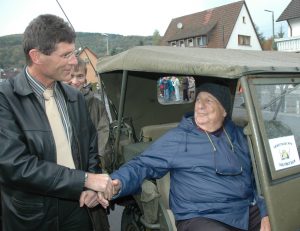
At another stop, the German Infantry School in Hammelburg, all the 1945-style “GIs” stood in the same cafeteria line with soldiers wearing modern German Army uniforms. Many puzzled looks, as if to say “Oh No!..They’re back!,” came from the Germans, many of whom had evidently not been informed about the impending “reinvasion.”
The retracing on Oct. 22-23, 2005, of Task Force Baum’s (TFB) Hammelburg Raid, one of the most fascinating and controversial chapters of WWII, was the brain child of two German Army soldiers, Lt. Col. Peter Domes and Master Sgt. Martin Heinlein, who have turned their hobby of gathering the complete history of this raid onto a German and English website (www.taskforcebaum.de). Domes and Heinlein, with the assistance of their 10-member Task Force Baum Working Group, have become the unquestioned world authorities on this raid.
When then Captain Baum and his armored task force of 313 men and 57 vehicles came thundering in the middle of the night on the daring mission through this 50 mile route of forested hills, wide valleys, and villages just east of Frankfurt, Baum was a 24-year-old, battle-hardened, handsome Jewish guy from the Bronx, with a thin Erroll Flynn style mustache.
In combat in France and at the Battle of the Bulge, Baum had earned several Bronze and Silver Stars, Purple Hearts, and the nickname “Able” — a guy with a bullhorn voice, decisive leadership, and undisputed courage. His reputation was that of an officer who always got the job done. Sixty-one years later, despite the recent artificial knee replacement, his leadership qualities and the sheer force of his personality are still evident to all, undiminished by time.
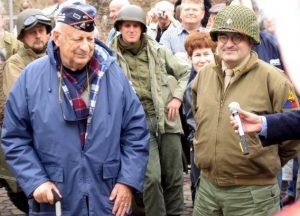
The raid was doomed to failure, with 25 of the raiders killed, most of the rest taken prisoner, and a score of American POWs killed. Col. Waters was seriously wounded in the melee, shot near the spine, and could not be moved. These failings lie with the planners of the raid, and not on its execution by Capt. Baum or his courageous men. Baum was wounded twice during the mission and had the Distinguished Service Cross pinned on him while still recuperating in a military hospital by Gen. Patton. After the war, Gen. Patton would admit to the Hammelburg raid as his “one mistake.”
The reenactors, about 40 strong, were history buffs, mostly civilians, coming from as far away as Munich and Czech Republic. Their passion for history is reflected in their beautifully restored Jeeps, half-tracks, uniforms, and equipment.

When Major Baum arrived on Saturday morning, Oct. 22, with Col. Domes by Jeep in a light rain at the tour’s starting point, the Nilkheim athletic field, he was astonished at the large number of military vehicles and spectators waiting there, and the GI reenactors standing in formation. The troops were commanded to attention by Sgt. Heinlein, and Major Baum conducted an inspection.
Then the convoy took off, following as closely as possible the original route of the raid, with traffic controlled by Fire Chief Herbert Hausmann and volunteers. The first stop was for a briefing at Laufach, where TFB lost its first tank and its first man KIA. The second briefing was at Bischbornerhof, where TFB opened fire on a large group of German soldiers doing their morning calisthenics in a field. The briefings were conducted by Col. Domes, Sgt. Heinlein, and various members of the TFB Working Group. After lunch and an official reception by Mayor Siegfried Selinger at the Rathaus in Lohr, the column’s next briefing stop was at Langenprozelten, and finally Gemuenden.
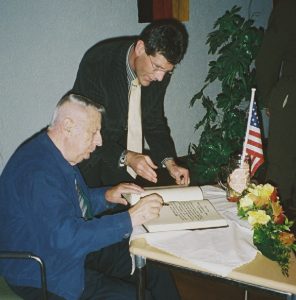
Another big surprise for Major Baum was Mayor Schiebel’s reception in the Town Hall of Gemuenden. Baum was led into the hall where the Mayor was waiting along with scores of spectators and photographers, and all the GIs standing at attention as an honor guard, which Baum passed in review — a moment richly symbolic and emotional. Mayor Schiebel gave a welcoming speech, and invited Baum to sign his name in the town’s Golden Book for distinguished visitors.
When TFB arrived in Gemuenden early in the morning of Mar. 27, 1945, the reception they received was decidedly unfriendly. The Germans suicidally blew up the Saale bridge in Baum’s face, knocked out 3 Sherman tanks, killed a half-dozen GIs, captured many more, and shot Baum’s right hand and leg full of shrapnel that cut to the bone. The defenders were mostly young combat engineers well-armed with Panzerfausts, the very effective one-shot, blunt-headed, armor-piercing rocket. The lost bridge forced Baum to take a detour to the north in search of a river crossing. Gemuenden suffered far more, being 2/3 burned to the ground and losing 65 civilians, mostly from Allied bombs in Mar.-Apr., 1945.
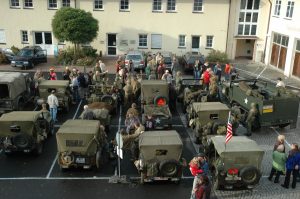
Old wounds were long since forgotten, however, at the festive dinner hosted by Gudrun Schneider and the Film-Photo-Sound Club at the Huttenschloss, a former castle near the embattled bridge, now housing their Museum. Following normal protocol, the GI enlisted men went through the chow line before the officers and dignitaries.
On Sunday morning, Oct. 23, the column rumbled off northward to Rieneck, where the good-natured Mayor Waldemar Horn appeared with a white flag, “surrendering” the town to Major Baum and inviting the entire group to breakfast.
Next stop was Burgsinn where a “guide/hostage” was captured (a friend of Col. Domes) and a briefing held. Here TFB found a bridge over the river, so they could proceed eastward to Hammelburg over back roads, aided by local guides. The next briefing stops were at Weickersgrueben and then Hammelburg, where the German Hetzers had ambushed TFB with broadside volleys, like ducks in a shooting gallery. The modern column was admitted to the German Army base where TFB had met its end. Lunch was served in the mess hall of the German Infantry School, reenactors in strange juxtaposition with regular German Army.
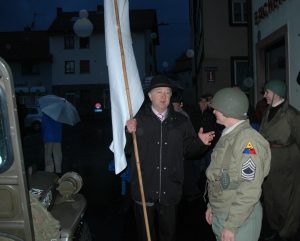
There was a briefing in Hoellrich, where one of the escape attempts was carried out, and finally the entire group assembled for a briefing, final words, thanks, and group photos on the flank of the “Reussenberg” (Hill 427) where the coordinated German attack on the morning of March 28 scattered the Task Force and ended any hope of escaping as a cohesive unit.
This beautifully planned and executed retracing event was originally intended by Col. Domes and Sgt. Heinlein as a reward for the TFB Working Group researchers, reporting their latest results along the way. When Major Baum agreed to attend, along with his wife Eileen, sons David and Eric, daughter Susan, and David’s wife Nancy, it became more of a celebrity event.
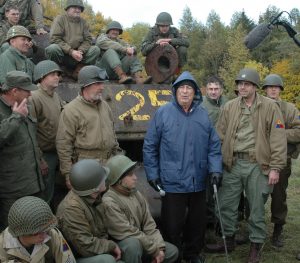
Domes’ and Heinlein’s passion for history has obviously infected the hundreds of participants and spectators in this event, testifying to the great public interest that remains in WWII. Their research results will soon appear in book form (“Alarm, die Panzerspitze kommt!” plus an English edition). Domes and Heinlein are also collaborators with the present author on a new screenplay, “Patton’s Secret Mission,” which will soon be searching for a producer. (Written Nov., 2005)
Ultimate Liberation of Hammelburg POW Camp
With the failure of Patton’s raid Mar. 26-28, 1945 on OFLAG XIII-B, the POW camp for Officers in Hammelburg, Germany, the prisoners both old (prior to the raid) and new (after the raid) had to wait another ten days for their freedom. Hammelburg is about 60 miles due east of Frankfurt. While Patton’s Third Army moved north and east through Frankfurt, Gen. Alexander Patch’s Seventh Army moved east through its assigned territory, including Hammelburg. (Patton’s raid on OFLAG XIII-B was not only unauthorized but out of bounds.)
To get to Hammelburg, on April 5 and 6, 1945, Combat Command B of Patch’s 14th Armored Division had to pass through Aschaffenburg, then Gemünden, then the village of Höllrich, and finally Lager Hammelburg, the former German army base lying a few miles south of Hammelburg town. Gemünden, being a railroad crossroad and marshalling yard, was about 60% destroyed by allied bombing during WWII. The bombing and probably artillery shelling was coordinated with the attack by the 14th Armored. I purchased and edited the following Signal Corps films from the National Archives, which was premiered to the local population of Gemünden during my visit there in March, 2005. Many of the scenes of the liberation of the Hammelburg POW camp are often mistaken for or deliberately substituted for the raid of Task Force Baum, which had no Signal Corps photographers attached. (15 minutes, silent but sound effects added)
Apr. 5, 1945, Combat Command B, 14th Armored Division, Seventh Army. Marching east on Rte. 28. At Langenprozelten they hitch rides in half-tracks close to Gemuenden. The Sinn-Saale bridge had been blown on Mar. 27 when Task Force Baum arrived. German prisoners. Troops must take rubber rafts around bridge. Sniper fire from railroad cars. Town afire, civilian arrested. Apr. 6, 1945, bridge repaired, Brig. Gen. Albert C. Smith of the 14th, 3rd Army crossing from east to west. Town still afire, women, nurses, dead body, German fire fighters, Hoellrich village, approach POW camp OFLAG XIII-B in Hammelburg, shoot lock on front gate, joyful Serbian officers greet Americans [15 min].
